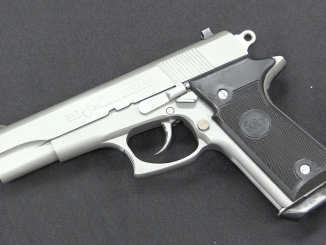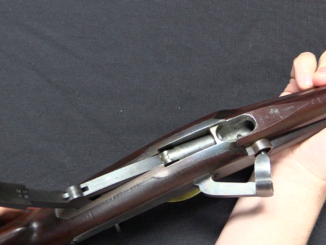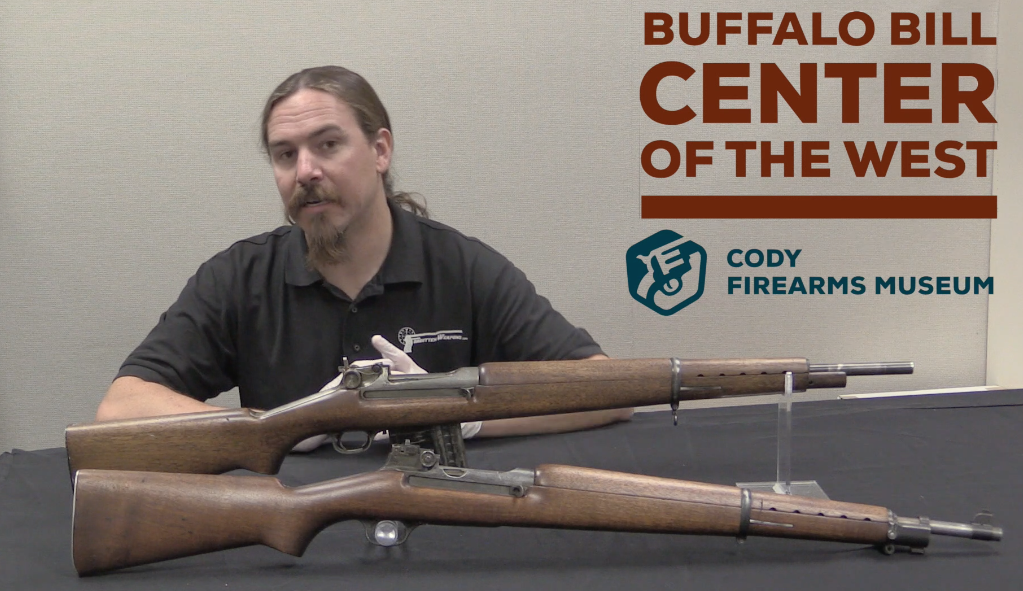The Palmer carbine was the first bolt action firearm adopted by the US military – it was a single shot rimfire carbine patented in 1863 and sold to the US cavalry in 1865. The guns were ordered during the Civil War, but were not delivered until just after the end of fighting, and thus never saw actual combat service. The design is very reminiscent of the later Ward-Burton rifle, using the same style of interrupted-thread locking lugs. The Palmer, however, has a separate hammer which must be cocked independently of the bolt operation.
Related Articles

Semiauto pistol
Colt Tries DA/SA: The Colt Double Eagle (in 10mm)

Single Shot Rifles
The Svelte Jenks Navy Carbine of the Mexican-American War

carbine williams

My dumb question of this day or any day: I fired cap guns, .22LR at the local YMCA. Learned to load centerfire in basically ANY caliber, but NEVER made a rim fire of any description. Did rim fire cartridges precede center fire, and WHY? Seems simple should precede complicated!
“Did rim fire cartridges precede center fire, and WHY? Seems simple should precede complicated!”
Considering only fixed cartridge, not earlier breech-loading fire-arms (assuming that fixed cartridge is disposable device*)
Needle-fire (invented by Pauly in 1808) it was invented first, but it get wider use in 1830s, alongside Dreyse rifle
Pin-fire (invented by Lefaucheux in 1830s) were first practical metallic cartridges. It can be easily used in revolvers and break-action shotgun, but not in repeating rifles, automatic pistols and self-loading rifles. Now it is only used in miniature fire-arms (see 2mm pinfire)
Rim-fire (invented by Flobert in 1840s), first rim-fire cartridge was .22 BB, it was created by joining primer cap with bullet (no powder), this cartridge later evolved in .22 Short (designed for S&W No. 1 revolver), .22 Long and .22 Extra Long. It is still used in some European countries, where license for this fire-arms is not required
Center-fire (invented independently by Berdan and colonel Boxer in 1860s)
(There also exist other less important …-fires)
* – modern cartridges may be reloaded multiple times, but early cartridges were designed to be disposable
Generally due to used manufacturing technology rim-fire cartridge are cheaper to produce that center-fire of same size, but center-fire can withstand much bigger pressure. Rim-fire cartridges for revolvers were quite popular till the end Age Of Black-powder, see .32 rim-fire and .38 rim-fire.
When in USA the firearms evolution was …->percussion cap->rim-fire->center-fire, Prussia has …->percussion cap->needle-fire->center-fire,
Great Britain has …->percussion cap->center-fire.
“and WHY? Seems simple should precede complicated!”
In fact rim-fire is simpler than center-fire. In center-fire you have primer which must be secured in cartridge so it wouldn’t “escape” from firing pin when it is striked and not allowing getting moisture inside cartridge.
If I were heading out West after the Civil War, this carbine would be a pretty good choice: a simple, handy, large-ish caliber weapon in a “service” round.
This carbine is slightly better than the Podewils Lindner Rifle in that it fires a metallic cartridge and not a percussion cap with paper cartridge. I’d stick with the Podewils if there were no convenient supply point for metallic rimfire rounds. Percussion caps were likely cheaper to buy anyway… Or am I wrong?
Percussion caps were and are relatively cheap. .56-.50 rimfire was a common cartridge at the time, however, and continued in manufacture for most of the 19th Century for all the surplus carbines out there. I wouldn’t hesitate to carry one if heading out, but I would have a muzzleloading shotgun in my saddle boot too. Nothing was ever more versatile than one of those babies for feeding yourself and self defense too.
The bolt-locking system not only resembles the Ward-Burton, but the interrupted-screw breech lock also showed up on artillery pieces. In small arms, it also was used in the 20th century, notably in the Newton and Weatherby bolt-action rifles, both of which were front-locking rather than rear-locking. The rear lock gets some bad press today, but it worked well enough on the Enfield family of service rifles, from the original Lee-Metford on up to the No. 4.
That rear sight is interesting. I noticed the “hole” in the 500-yard leaf, and I’m wondering if it wasn’t intended as a “battlesight” peep sight, rather like the “D” setting on the rear sight of the SKS and AK.
With their sliders set on D, if you aim center-chest on a man-sized target at any range from point-blank to 300 meters, the bullet will hit somewhere on a vertical line between the waist and the neck. Which is “close enough for government work”, as they say.
This would be less practical on a Spencer-chambered weapon, of course, due to is lower velocity and consequent rainbow-like trajectory, but I can’t help wondering if that was the designer’s intent.
cheers
eon
From mid-May to early June of 1865, a battle raged in the Texas port town of Brownsville, possibly because the Confederate troops stationed on the Southern front were not aware that the Northern front already surrendered six days before Lincoln’s assassination. The Palmer rifle’s late delivery was copied more than five decades later when the ship scheduled to deliver the Thompson sub-machine gun to US troops in France only got the go-ahead to sail when the November armistice was declared. Meanwhile-on-the-Eastern-European-Front, a civil war was raging between the Bolshevik leadership and the troops from the ousted Tsarist regime. During-the-second-half-of-1918, President Woodrow Wilson sent a contingent of US troops to North Russia to bolster the limited force size of French and British troops.
For the contingent, the force size had 20 British Navy vessels, two British Army rifle battalions, about 8,000 US Army soldiers, 14 Canadian and Australian battalions, 2,000 French troops, 1,000 Polish and Serb-British riflemen to assist Kolchak’s White Guard in Murmansk, and one RAF squadron.
Opposing the contingent were the mobilized-in-Mid-May Bolshevik’s 7th and 8th Armies stationed in the Northwest Sector. To-sum-it-up, the Polar Bear Expedition from mid-November of 1918 to January 1919 was the closest the Tommy Gun had to seeing action in the First World War.
Point?
I have one of these, but in a lot better condition. I wish i could find some ammo.